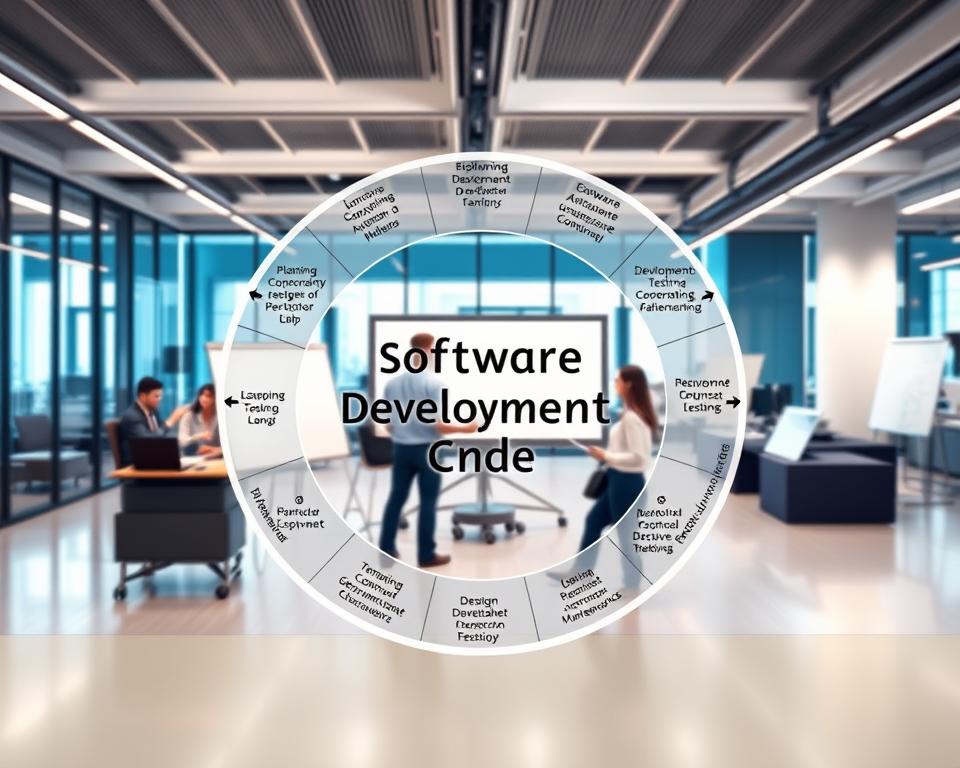
The Software Development Life Cycle: A Comprehensive Guide
Did you know that a staggering 70% of software projects fail to meet their original objectives due to poor planning and mismanagement? The Stages in the software development life cycle (SDLC) is integral in overcoming these hurdles by providing a structured framework for developers. This comprehensive guide will walk you through each essential stage of the SDLC, helping ensure that your software development project adheres to its goals and meets user expectations.
Understanding the intricacies of the SDLC is crucial for anyone involved in software creation, as it encompasses everything from planning to maintenance. So, how many stages are in the software development life cycle? In the following sections, we will break down these stages, providing insights and valuable information that will serve to enhance your knowledge and application of the SDLC.

Key Takeaways
- The software development life cycle (SDLC) consists of multiple stages that guide software projects from inception to deployment.
- Effective project management can significantly enhance the likelihood of project success.
- Understanding different software development methodologies is key to choosing the right approach for your project.
- Quality assurance and testing are vital to ensure the functionality and excellence of the software.
- Future trends in software development continuously evolve, highlighting the need for adaptability in methodology and tools.
Introduction to the Software Development Life Cycle
The software development life cycle explained is an essential framework that guides the process of creating software. The introduction to SDLC focuses on the systematic approach required to deliver high-quality software products. By outlining the stages involved, this model promotes a more efficient workflow, allowing teams to identify and address challenges proactively.
Each phase in the SDLC serves a specific purpose, facilitating clear communication among stakeholders and ensuring all requirements are met. This structured process not only enhances project success rates but also aids in resource management, leading to cost-effective solutions. Understanding the software development life cycle provides valuable insights into how projects can be managed more effectively, ultimately benefiting both developers and end users.
Understanding the Software Development Process
Software development is a systematic approach to creating software applications, involving several phases that contribute to the end product. This structured methodology enables developers to manage complexity, foster collaboration, and streamline the entire software development process. From defining requirements to deployment, understanding the various stages of software development life cycle is essential for producing high-quality software.
What is Software Development?
At its core, software development encompasses the planning, coding, testing, and maintenance of software. Developers utilize various programming languages, frameworks, and tools to bring ideas to life. The software development process not only involves technical skills but also requires creativity and problem-solving abilities to craft solutions that meet user needs.
The Importance of a Structured Process
Employing a structured process within the software development environment promotes clarity and efficiency. By following well-defined software development stages, teams can reduce risks and enhance communication among stakeholders. A robust framework guides the development lifecycle, leading to better project visibility, timely deliveries, and ultimately, successful project outcomes.

How Many Stages in the Software Development Life Cycle
The software development life cycle (SDLC) is a structured process designed to develop quality software. Understanding how many stages in the software development life cycle is essential for effective management and execution. Typically, the SDLC includes six to seven distinct phases, each contributing to the overall success of a project.
The primary sdlc phases include:
- Planning
- Analysis
- Design
- Implementation
- Testing
- Deployment
- Maintenance
Each phase serves a specific purpose that integrates into the software development process. Knowing how many stages in the software development life cycle helps teams strategize their workflow, manage time effectively, and allocate resources where necessary. This structured approach ensures all aspects of software development are covered, paving the way for more advanced exploration of each phase later on.
The Stages of the Software Development Life Cycle
The software development life cycle consists of various structured phases that guide the overall process. The initial steps set the foundation for a successful project, focusing on critical aspects such as resource allocation, requirements gathering, and stakeholder communication. Proper execution in these stages plays an essential role in ensuring a seamless transition to later phases.
Planning Phase
The planning phase serves as the cornerstone of any software development project. During this stage, teams outline the project scope, define objectives, and establish a preliminary budget. Key activities include:
- Identifying project stakeholders
- Estimating a timeline and budget
- Assessing risks and resource needs
Smart planning significantly influences the subsequent phases of the software development life cycle by ensuring that all parties understand the project’s goals and constraints. A well-conceived plan minimizes uncertainty and promotes alignment among team members.
Analysis Phase
The analysis phase focuses on collecting and refining requirements through comprehensive stakeholder engagement. This phase involves key tasks such as:
- Conducting interviews and surveys with users
- Analyzing competitor offerings and market needs
- Documenting functional and non-functional requirements
Thorough analysis leads to a clearer understanding of user expectations and helps outline essential features of the software. By investing time in this phase, teams can identify potential gaps and make informed decisions throughout the steps in the software development process.
Design Phase in Software Development
The software design phase is a critical component of the software development life cycle phases. This stage focuses on translating requirements and specifications defined in the previous analysis phase into a comprehensive plan for the system. During this phase, the architectural framework is developed, specifying how components will interact with each other.
Key elements of the software design phase include:
- Software Specifications: A detailed description of the software’s functionality, performance, and interaction.
- Architecture: The foundational structure of the software, outlining how different elements will work together.
- User Interface Design: Creating layouts and interfaces that enhance user experience and engagement.
- Technology Stack: Selecting appropriate tools, frameworks, and programming languages to be used in development.
It is imperative that all design aspects align with project requirements gathered during the analysis phase. This alignment ensures that the final product meets user needs and expectations, creating a strong foundation for subsequent phases in the software development life cycle.
| Design Element | Description |
|---|---|
| Software Specifications | A clear and concise outline of what the software needs to achieve. |
| Architecture | The organizational structure defining how software components communicate. |
| User Interface Design | Visual and interactive elements designed to facilitate user interaction. |
| Technology Stack | The collection of programming languages and frameworks used for development. |
Implementation in Software Development
The implementation in software development serves as a crucial phase where planned designs are transformed into functional code. This stage is where developers apply various techniques and strategies to ensure that their coding aligns with the original vision. By adhering to effective code development practices, teams can facilitate smoother transitions from abstract ideas to tangible software solutions.
Code Development Practices
Implementing robust code development practices is vital for successful software projects. These practices help maintain clarity and quality in code, promoting long-term sustainability. Some key practices include:
- Clean Coding: Writing code that is easy to read and understand, which reduces potential bugs and technical debt.
- Version Control: Utilizing systems like Git to track changes, enabling team collaboration and effective project management.
- Commenting: Adding meaningful comments in the code, helping others (and future you) understand the logic and purpose of specific functions.
Integrating Development Tools
To maximize efficiency during the implementation phase, integrating development tools becomes essential. Tools such as Integrated Development Environments (IDEs) and Continuous Integration/Continuous Deployment (CI/CD) platforms streamline the coding process. By leveraging these tools, teams can automate repetitive tasks, perform testing, and facilitate a consistent workflow.
| Development Tools | Features | Benefits |
|---|---|---|
| IDEs | Code editing, debugging, and testing | Improves coding speed and accuracy |
| CI/CD Tools | Automated build and testing | Reduces manual effort and enhances deployment frequency |
| Project Management Software | Task allocation, progress tracking | Streamlines communication and improves team collaboration |
Testing Phase Overview
The testing phase in software development serves as a critical checkpoint in the software lifecycle. It ensures that the developed application meets specified requirements and functions as intended. This phase allows teams to identify defects or issues early, thereby saving time and resources in the long run.
Types of Testing in Software Development
Several types of testing are conducted during the testing phase to cover various aspects of the software. These include:
- Unit Testing: Assesses individual components for correctness.
- Integration Testing: Examines how different modules interact with one another.
- System Testing: Validates the complete and integrated software product against specified requirements.
- Acceptance Testing: Ensures that the software meets the acceptance criteria defined by stakeholders.
The Importance of Quality Assurance
Quality assurance in software development is integral to maintaining high standards. It ensures that the software not only performs well but also aligns with user expectations and industry standards. Implementing quality assurance practices throughout the testing phase reduces risks, increases user satisfaction, and ultimately leads to a successful software deployment.
Deployment and Maintenance of Software
Software deployment marks a significant milestone in the software development life cycle, transforming a project into a tangible product for end-users. This phase involves various strategies, including cloud-based platforms, on-premises installation, or hybrid approaches, ensuring that all users can access the software efficiently. Identifying the most suitable deployment method is essential for optimized performance and user satisfaction.
Post-deployment, the focus shifts to software maintenance, which is critical for the longevity and effectiveness of the application. Regular updates and enhancements not only fix bugs but also introduce new features that keep the software relevant in a rapidly changing technological landscape. Listening to user feedback during this phase is invaluable; it guides necessary adjustments and improvements.
Effective software maintenance fosters a proactive approach toward potential issues, resulting in reduced downtime and increased user satisfaction. Monitoring software performance can highlight areas needing improvement, ensuring the software continues to fulfill user needs over time.
Project Management for Software Development
Effective project management for software development is vital for ensuring the successful delivery of software products. By applying structured methods, teams can enhance productivity, mitigate risks, and align development goals with business objectives. Understanding different management strategies and utilizing appropriate tools can significantly impact project outcomes.
Effective Project Management Strategies
When it comes to project management for software development, several effective project management strategies stand out. Popular methodologies like Agile and Waterfall provide frameworks for organizing tasks and managing workflows. Agile focuses on iterative development, allowing teams to adapt and respond to changes quickly. In contrast, Waterfall follows a sequential path, making it easier to track progress and manage timelines.
- Agile Methodology: Emphasizes flexibility and customer collaboration.
- Waterfall Methodology: Offers a linear approach with distinct phases.
- Scrum: Facilitates short development cycles called sprints for rapid delivery.
Tools for Managing Software Development Projects
Using the right tools is crucial to implement effective project management strategies. Tools like JIRA and Trello help teams manage tasks, track progress, and facilitate communication. These platforms provide visual representations of project status, enabling team members to understand their responsibilities and deadlines clearly.
| Tool | Description | Key Features |
|---|---|---|
| JIRA | A robust tool widely used for issue tracking and project management. | Custom workflows, reporting features, and Agile support. |
| Trello | An intuitive, card-based organization tool perfect for smaller teams. | Drag-and-drop interface, checklists, and collaboration options. |
| Asana | A versatile tool that manages tasks across various projects. | Project timelines, task assignments, and progress tracking. |
Software Development Methodologies
Choosing the right software development methodology can significantly impact the success of a project. Understanding the differences between popular approaches, particularly agile vs. waterfall, allows teams to align their strategies with project goals, team dynamics, and timelines. Each methodology has its own strengths and challenges that can affect how effectively a project progresses.
Agile vs. Waterfall Methodologies
The agile methodology promotes iterative development, allowing teams to adapt and respond to changes quickly. Its advantages include increased flexibility and enhanced collaboration. Regular feedback from stakeholders ensures that the final product aligns with user expectations. On the other hand, the waterfall methodology follows a linear approach where requirements are specified upfront. This can lead to a more structured, predictable timeline, but it may lack the adaptability of agile.
| Feature | Agile | Waterfall |
|---|---|---|
| Flexibility | High | Low |
| Stakeholder Engagement | Continuous | At milestones |
| Delivery Model | Incremental | Sequential |
| Adaptability to Change | Excellent | Limited |
Choosing the Right Methodology for Your Project
When selecting a methodology, consider your project’s specific requirements. An agile approach may be ideal for projects needing flexibility and rapid adaptation. Conversely, waterfall might suit projects with clearly defined stages and fixed requirements. Assessing team structure and timelines can further guide the decision, leading to more effective software development methodologies.
Software Development Life Cycle Models
Understanding various software development life cycle models is crucial for selecting the most suitable approach for a project. Different models cater to specific project needs, complexities, and team dynamics. By exploring popular SDLC models, businesses can find effective methods that align with their unique requirements.
Popular SDLC Models Explained
Several software development life cycle models exist, each with distinct characteristics. Below are three of the most well-known models:
- Waterfall Model: Sequential phases where each phase must be completed before the next one begins. Best for projects with clear requirements.
- Agile Model: Focuses on iterative development, enabling flexibility and rapid adjustments based on user feedback. Ideal for projects where requirements evolve.
- Spiral Model: Combines iterative development with the systematic aspects of the Waterfall model. Suitable for complex and high-risk projects.
Choosing the Right SDLC Model for Your Needs
When choosing the right SDLC model, consider factors such as team size, project complexity, and stakeholder involvement. A thoughtful evaluation will facilitate an informed decision and improve collaboration throughout the development lifecycle. By understanding the strengths and limitations of each model, organizations can effectively tailor their strategies to optimize results.
Common Challenges and Solutions in SDLC
The software development life cycle (SDLC) presents numerous challenges that teams often encounter. Some of the most prevalent challenges in software development include scope creep, which can derail project timelines and budgets. Budget overruns frequently occur when unforeseen issues arise, impacting overall project costs. Communication issues can arise among team members or stakeholders, leading to misunderstandings and project delays.
To address these challenges in software development, implementing effective solutions in SDLC is critical. For instance, establishing clear project boundaries from the outset can help mitigate scope creep. Regular budget reviews and adjustments allow teams to stay in control of expenses. Enhancing communication through regular meetings and updates can significantly lead to improved collaboration across different departments.
Understanding these challenges and deploying targeted solutions in SDLC empowers project managers to navigate complexities more effectively. Keeping teams informed and engaged fosters a collaborative environment, driving the success of software development projects.
| Challenge | Potential Solution |
|---|---|
| Scope Creep | Establish clear project requirements and boundaries |
| Budget Overruns | Conduct regular budget reviews and implement contingency plans |
| Communication Issues | Schedule regular meetings and maintain open channels for feedback |
Best Practices for Success in Software Development
Achieving success in software development relies heavily on adhering to best practices in software development. Effective communication among team members fosters collaboration, leading to more innovative solutions. Establishing regular check-ins can help clarify goals and address challenges before they escalate.
Documentation plays a crucial role in ensuring that everyone is on the same page. Creating comprehensive documentation of processes, decisions, and code not only aids current team members but also supports future projects and team onboarding. Ensuring that this documentation is kept up-to-date is part of the successful software development tips.
Iterative development is another key aspect. Employing incremental releases allows teams to gather feedback early and often. This approach helps in adjusting project direction based on user input and testing results, minimizing the impact of late-stage changes.
Thorough testing cannot be overlooked. Prioritizing different types of testing, such as unit, integration, and acceptance testing, ensures high-quality outcomes. Rigorous testing helps identify potential bugs early in the process, which saves both time and resources in the long run.
| Best Practice | Description |
|---|---|
| Regular Communication | Ensures clarity and fosters collaboration among team members. |
| Documentation | Provides a clear understanding of processes and aids onboarding. |
| Iterative Development | Incorporates user feedback through incremental releases. |
| Thorough Testing | Identifies bugs early, ensuring high-quality software delivery. |
Real-life Examples of SDLC in Action
Exploring real-life SDLC examples provides valuable insights into the practical application of the Software Development Life Cycle. Analyzing case studies in software development reveals the challenges encountered and the strategies implemented to achieve success. For instance, the development of the iOS operating system highlights a robust planning phase, where Apple meticulously considered user feedback before implementation.
Another compelling example comes from the development of Spotify. Its agile methodology allowed for rapid prototyping and constant iteration. This adaptability enabled the team to address user preferences effectively, demonstrating the power of flexibility within the SDLC framework.
Furthermore, the creation of Microsoft Office showcases rigorous testing within its development process. With thousands of test scenarios, Microsoft focused on quality assurance to ensure a seamless user experience, emphasizing the critical role that testing phases play in software development.
In each case, the blend of structured processes and real-world adjustments resulted in software solutions that not only met market demands but also set industry standards. These real-life SDLC examples serve to inspire and guide future software projects, illustrating the importance of learning from previous endeavors.
Tools and Technologies in the Software Development Life Cycle
In the realm of software development, utilizing the right tools is essential for enhancing productivity and fostering collaboration. Various tools in software development streamline processes from initial requirements gathering through maintenance, ensuring a smoother workflow.
Project management software, such as Jira and Trello, assists teams in tracking tasks and progress. Version control systems like Git provide a robust platform for code collaboration, enabling developers to manage changes effectively. Continuous integration tools, such as Jenkins, automate testing and deployment, significantly reducing the risk of integration issues.
Employing appropriate technologies for SDLC can greatly impact the project’s success. For instance, cloud-based platforms like AWS and Azure offer scalable resources for deployment and testing environments. Additionally, various testing frameworks, including Selenium and JUnit, facilitate automated testing, ensuring that the software meets quality standards before release.
The adoption of these tools not only enhances efficiency but also promotes better communication among team members, leading to higher-quality software. Organizations must continuously evaluate and integrate new technologies into their processes, maintaining a competitive edge in the ever-evolving software landscape.
The Future of Software Development
The landscape of software development is continually evolving, shaped by future trends in software development that include innovations like artificial intelligence, machine learning, and low-code platforms. These emerging technologies in SDLC are set to redefine how developers create, maintain, and deploy software. Teams that harness these advancements can expect increased efficiency and enhanced collaboration throughout the development cycle.
Artificial intelligence is already making strides in automating repetitive tasks, which allows developers to focus on more complex problems. Machine learning algorithms are becoming indispensable in predictive analytics, enabling teams to foresee potential issues before they arise. Low-code platforms, on the other hand, simplify the development process, allowing even those with minimal coding experience to participate actively in building applications.
The integration of these technologies not only streamlines the software development life cycle but also opens up new horizons for innovation. Companies that adapt to these changes can gain a competitive edge, responding more effectively to market demands and user requirements. As these future trends in software development unfold, the industry will likely witness a shift towards more agile, collaborative, and efficient development practices.
Conclusion
In this summary of the software development life cycle, we’ve explored various phases, methodologies, and best practices that are instrumental for effective software development. The SDLC is not merely a checklist; it is a comprehensive framework that guides teams from the initial planning stages through deployment and maintenance. Understanding each stage ensures that projects stay on track and meet user needs efficiently.
Key takeaways on SDLC highlight the importance of structured processes, which allow teams to manage complexities and mitigate risks effectively. By applying the insights gathered in this article to your future projects, you will position yourself for success in developing high-quality software that meets both business objectives and user expectations.
Ultimately, a solid grasp of the software development life cycle offers a roadmap for navigating challenges in technology projects. Whether you’re just starting your journey in software development or are looking to refine your process, the principles discussed here serve as a vital resource for continuous improvement and innovation.





